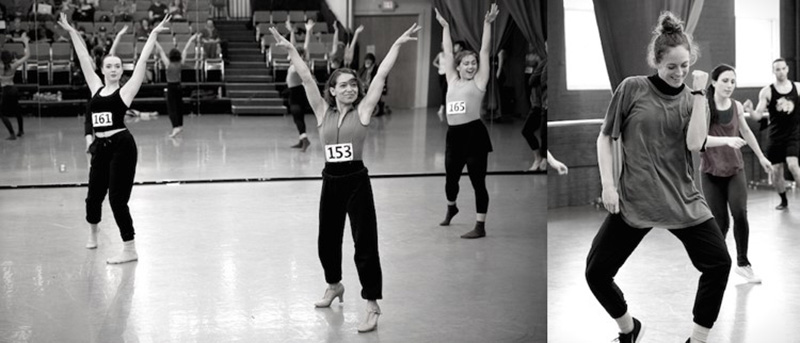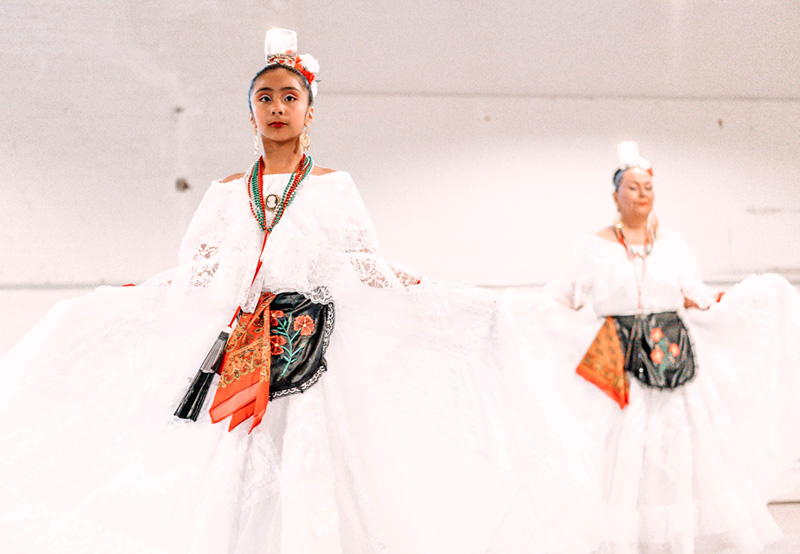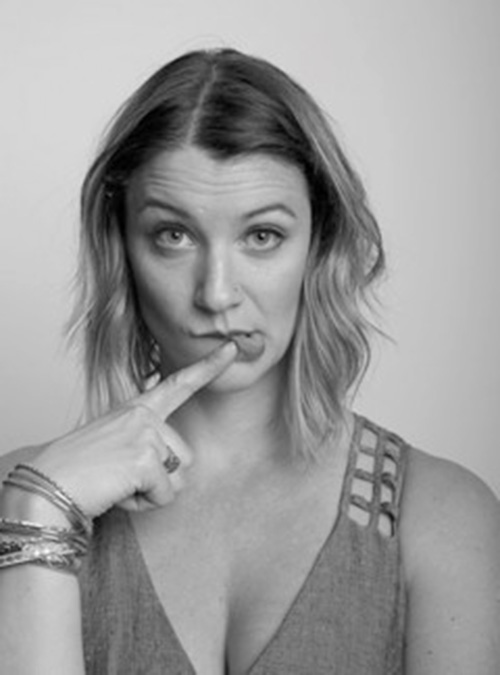Portland’s Dance Wire Promotes Visibility and Connectivity
An Interview with Emily Running
BY EMMALY WIEDERHOLT
Emily Running is a freelance dance artist and the founder and director of Dance Wire, an organization that aims to enhance the prosperity and visibility of dance in Portland, OR. She discusses how and why she initiated Dance Wire, how it’s organized, and her hopes for making dance an integral part of more people’s lives.
~~
Can you tell me a little about your dance history – what kinds of performance practices and in what contexts have shaped who you are today?
I have been dancing since age five. I started with ballet and jazz in the town where I grew up in Montana. That’s what was available there. I started doing modern, improv and choreography in college, as well as pedagogy and kinesiology. I moved to LA after college and danced with a few contemporary companies – Vox, Diavolo and Method. Then I moved to Portland and started dancing with an aerial company, A-WOL Dance Collective, who I was with for seven years. I also danced with POV, and I’m currently dancing with the ELa FaLa Collective – both contemporary companies.
Throughout my career, I’ve been a freelance artist doing a wide range of projects, for which I now have a Patreon page. Follow along if you’re interested in learning more about the creative process and what it looks like to be a freelance dancer!
In between living in LA and Portland, I moved to Paris for a year. I didn’t move to Paris to dance specifically, but rather because I was 25, and it sounded like a great idea. I did audition for a few things while I was there, but the ironic part is that I didn’t have a work visa, so they couldn’t hire me. That experience shaped me as a person and as an artist. In France, they understand the arts differently. It’s steeped into their culture. They know the arts have value and that artists shape culture, drive difficult conversations, and are critical to the forward motion of society.
How did Dance Wire come about?
I went through a health crisis, which then turned into an identity and livelihood crisis – which I wrote a book about called Anatomy Riot. Basically, eight years ago, I was diagnosed with hip dysplasia, a congenital malformation of the hip socket. They didn’t catch and fix it when I was a child, so my hips have been structurally off my whole life. After the massive surgery I needed, I didn’t want to go back to making a living physically, even if that were an option. While applying endlessly for jobs that didn’t suit my skills or interest, the idea of Dance Wire popped into my head, and I knew it was what I wanted to do. I officially started Dance Wire in September 2013 though I spent a year before that talking to mentors and doing research.
What previous experience did you have that led you to begin Dance Wire?
Throughout the years, I have worked with multiple arts organizations in various stages of growth and in almost every capacity including education, membership, marketing, programs, fundraising, community partnerships, financial management, strategic planning and operations. It’s kind of what you do as a performing artist. You try to find work that pays but doesn’t lead you too far astray from your focus on dancing. In LA, I worked with Diavolo to create their education program, from developing the curriculum to going into the schools and teaching. When I got to Portland and started with A-WOL, the aerial company, I did something similar. However, at A-WOL, there were structural changes that were happening simultaneously, for example, they didn’t yet have their own space. I ended up working with them on figuring out how to get space and funding in addition to starting the education program. So, in several different contexts, I’ve done the startup thing, which often includes being resourceful and figuring it out as you go.
How is Dance Wire structured?
For the first four years, it was just me. I played every role in the organization – membership, finances, marketing, development, grant writer, etc. I had volunteers and a board of directors, but the day-to-day work I did myself. It came to a point where I couldn’t manage it alone anymore. My brain was going in too many directions at once.
In 2017 I wrote a grant to create a Member Services position for one of my long-time volunteers, Kate Rafter. Her job is extremely part-time, probably ten hours a week. But it has taken enough off my plate to allow me to focus on everything else, including the critical role of being the visionary for Dance Wire.
The more we grow, the more paid staff I need to do things that I don’t specialize in, such as technology. It’s tricky, because about 1,500 hours per year of my time is still unpaid, yet funders are not interested in paying for work that’s already being done. I have two grants out currently to fund a Funds Development person and a Website Support person. We are also working on new earned revenue sources as well as increasing donations from individuals and developing more business sponsorships.
My board is very proactive, and each person serves on a committee of two with me. Brian Rapp and I are the Finance Committee, Kathleen Adam and I are the Events Committee, and Megan Armand and I are the Design and Marketing Committee.
Finally, we recruit 10 ambassadors each year. They are all active dance artists of various ages who represent a range of dance styles. Their role is to help keep Dance Wire connected to all areas of the dance community and get the word out about who we are and what we do.
A Mexican Folkloric performance at Dance Wire’s Ambassador Showcase; Photo by Megan Armand
What need did Dance Wire answer that you believe wasn’t previously being met?
I’ve always had a dual vision. For the dance community, it’s really about connectivity and visibility. For the general public, it’s about driving more interest in dance. And those two really go hand-in-hand.
Starting with the public-facing side of our work, dance is an underrated art form, and yet it serves so many purposes – expression, social interaction, fitness, learning about and/or honoring one’s culture, joy! There are so many reasons why dance should be part of people’s everyday lives, and yet it isn’t. As someone who has danced all my life, I know these things in my bones. But there are still a lot of stigmas and stereotypes surrounding dance that prevent people from feeling like it’s “for them.” Beyond showing people what opportunities are out there, Dance Wire wants to invite them to participate while making it easy and fun to start exploring.
Then there’s the dance community-facing side of our work. What’s the one thing that every company, studio and choreographer wants? They want more people to come to their shows or take their classes. Inviting new people in and showing them what’s available seems evident to me. Another critical need is for artists to have resources to be the tiny (or towering!) businesses they need to be to do their work. An artist-incubator-coworking space-professional-development-center is part of my vision for the future.
What does Dance Wire offer?
So many things!
The public resources include a directory of studios so people can browse for classes based on genre, age and level. The calendar of events includes performances, participatory events, festivals, workshops and fundraisers. We have a video blog called Performance Previews, where people can watch video trailers of upcoming shows. I write monthly feature articles on dance companies to introduce people to some of the unique things going on in the city. An inspiring and recent addition is a new series of interviews called Dance CURIOUS. The series is about everyday people whose lives have been touched by dance, but not by pursuing it as a career. For example, it recently featured a guy who was utterly embarrassed to dance in grade school but took it in college as a required course. He said it built his confidence speaking in front of large groups, showing his students how to do tasks that are not always easy, and helping him relieve unwanted stress. He is a K-8 teacher who uses dance in his classroom all the time.
As far as resources for the dance community, all our public-facing resources listed above help increase the visibility of our members. Additionally, we offer resources, information and services that help individual artists advance their careers, and companies and studios expand their audiences. The most popular resources are a job board, templates and guides for writing and sending press releases, and a directory of dance medicine providers. We also host a city-wide dance audition each year. This past year, about 90 dancers attended, and 22 companies/choreographers/casting agents came.
One thing to note is that we operate on a membership model. That means dance artists and organizations pay a small annual fee to be included in our network. It’s a necessary component for keeping us afloat. We are currently working on a paid monthly subscription package for our general audience with fun perks, unique content and invitations to events.
What has been easiest about organizing Dance Wire? Vice versa, what’s been your biggest challenge?
The easiest thing is generating ideas! The inevitable challenge that goes along with that is narrowing it down to what is possible to accomplish with limited person-power and financial resources.
A challenge that I’m currently facing is owning my role as the face of Dance Wire. When I started Dance Wire, I didn’t want it to be about me personally. It felt tricky at the time. I’m an artist myself, but I didn’t want the people to confuse Dance Wire with the companies I was dancing or teaching for. Nor did I want people to think it was somehow tied to promoting my personal freelance work.
Consequently, I made myself invisible. I didn’t tell the founders story. I didn’t put my face out there. As a result, I got feedback that nobody knew who was behind Dance Wire, and it felt very institutional. I think the organization has taken on a life of its own enough now that I’m not worried about those things. In fact, if anything, it’s an asset that I am a working artist. I am part of the community Dance Wire serves.
Now I take it as a compliment that we appear polished enough to be institutional, though I am backtracking to tell my founder’s story and give people the real picture of the stage we are at. We’re not a big organization with a giant budget!
How would you like to grow Dance Wire in the future?
When I visualize the future, I go back to my experience in Paris. It’s hard to describe precisely because it’s a long-term vision with thousands of micro-steps needed to get there. In general, it’s a cultural shift. It’s a world where people aren’t afraid of their bodies, and where dance doesn’t feel exclusive to those with the right body type or who are in a certain income bracket. And where those who choose to pursue dance professionally are valued and prepared with the tools they need to succeed in their jobs.
How have you personally grown since initiating Dance Wire?
I recently started talking to a friend every week who is in the startup phase of launching her business. It’s been a reminder of how emotionally taxing it is! I often point out that it’s the highest of highs and lowest of lows. If you get a big win, it’s incredible, and you feel like you are conquering the world doing what you love. But if you get a significant loss, the responsibility and failure are all yours. One way I have grown is managing that fluctuation and seeing the bigger picture. I know there will be many more wins and losses, both big and small, but I have to continue marching forward no matter what. It used to feel like an exhausting scramble. Now it feels like a journey and a mission.
Emily Running, Photo by Lasting Light Photography
~~
To learn more, visit dancewirepdx.org.



